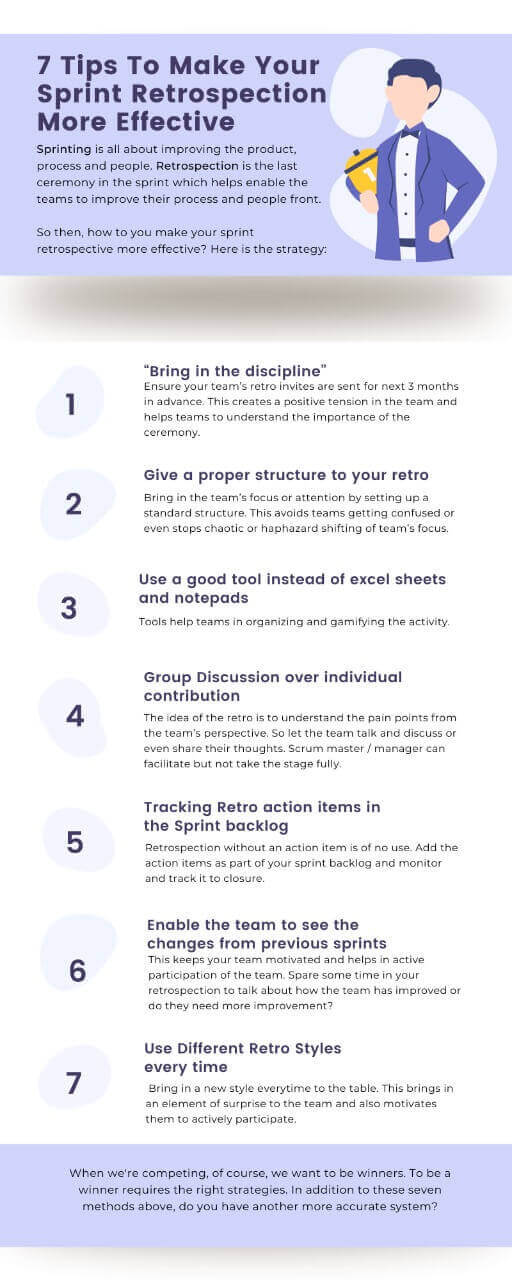Sprinting is all about improving the product, process and people. Retrospection is the last ceremony in the sprint which helps enable the teams to improve their process and people front. While it is one of the crucial ceremonies, retro is also the most ignored ceremony amongst teams.
Below are a few very common antipatterns which we have observed across teams in various companies,
- Teams tend to cancel their retrospection while utilizing the time allocated for some dev work
- Team members usually do not show up because they think they don’t have enough data to share
- Team is tired and want to close the sprint after a tiring demo / sprint review ( Usually retro happens on fridays EOD )
While with these anti beliefs and patterns, teams tend to not gain anything from retrospection and stop doing it in their sprints.
Below are 7 tips to make full use of retrospection and enable your teams to get better every sprint.

Bring in the Discipline
Ensure your team’s retro invites are sent in advance for next three months.. This creates a positive tension in the team and also helps the teams to understand the seriousness of the ceremony.
Give a proper structure to your retro
Bring in the team’s focus or attention by setting up a standard structure. This avoids teams getting confused or even stops chaotic or haphazard shifting of team’s focus. A simple example for a 1 hour retro is as shown below
- Team gets 20 minutes to input their ideas and thoughts in the tool
- Spare 10 minutes of the time for voting
- Have a healthy discussion for 20 minutes
- Last 10 minutes is to identify Action Items for next sprint
Use a good tool instead of excel sheets and notepads
Tools help teams in organizing and gamifying the activity. There are so many tools available to run a retrospection which promotes different types of retro and bring in gamification concepts. Using the same excel sheet or notepads will bore your audience and people tend to lose interest in the whole ceremony.
Group Discussion over individual contribution
We have often observed that only the scrum master drives the ceremony, or the manager is constantly talking about we need to do this , we need to do that etc etc. This puts your team at a backseat. The idea of the retro is to understand the pain points and hiccups from the team’s perspective, so let the team talk and discuss or even share their thoughts. Scrum master / manager can facilitate but not take the stage fully.
Tracking Retro action items in the Sprint backlog
Retrospection without an action item is of no use. Identifying areas for improvement and acting on it is the whole purpose of doing the retro. Do not just copy the retro points in an excel sheet or send an email and forget about it. Add the action items as part of your sprint backlog and monitor and track it to closure.
Elevate your service delivery with agile service management training that fosters responsiveness and enhances customer satisfaction.
Enable the team to see the changes from previous sprints
During the retro it is important for the team to see , feel or visualize the improvements. This keeps your team motivated and helps in active participation of the team. Spare some time in your retrospection to talk about how the team has improved or do they need more improvement.
Use Different Retro Styles every time
The basic ideology behind retrospection is to understand the pain points / hiccups and finding a way to improve them during sprints. There are tons of ways to do retro. Glad – Bad -Sad , 5 Whys, Lean Coffee , Start – Stop – Continue , 4 L’s etc are a few interesting retro styles. Bring in a new style everytime to the table. This brings in an element of surprise to the team and also motivates them to actively participate.
For more insight, blogs and articles on Agile, please visit Benzne Blog
Sujith Srivathsav
Agile Consultant

